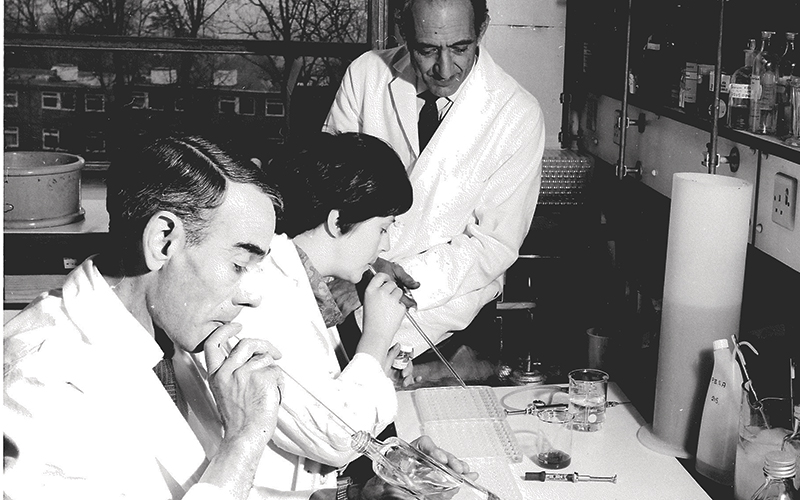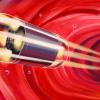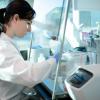It is 60 years since the micropipette was invented in Germany. To mark the anniversary, John Windell revisits the circumstances of its creation.

Of all the great scientific advances, the pipette is among the most unassuming. It is a commonplace item found in every lab in every hospital and research centre around the world. But make no mistake – the humble pipette has played a major role in clearing the way for some of the giant leaps we have seen in biology, chemistry and medicine in recent decades.
The pipette as we know it today made its debut 60 years ago in 1957 in Germany. Its story begins with the 32-year-old physician Heinrich Schnitger joining Theodor Bücher’s research team at the Institute of Physiological Chemistry at the University of Marburg, testing and measuring optical enzymes.
Schnitger was set to work on anion exchange chromatography. He watched intently as a gravity-driven contraption separated nucleotides and metabolites, then collected the minuscule samples for further analysis. The son of an inventor, Schnitger had already come up with an improved device for measuring blood coagulation and felt he could improve the gravitational process. He assembled
a piston-driven pumping system that was quicker and gave far more accurate control. Everybody was impressed, but for Schnitger this solution threw up a new challenge – how to collect and manage all those tiny samples.
It would have to be done by pipette, which at that point was a crude and inefficient instrument. It lacked fine control and presented researchers with the unappealing prospect of having to suck up liquids by mouth. Anecdotal evidence told of scientists taking mouthfuls of foul and dangerous substances. One story had it that a physician accidentally sucked up a sample of typhoid bacilli.
Schnitger set about developing a new pipette that would be more accurate, reliable and easier to use. He committed all his time and energy to the task – his routine work would have to wait, so he absented himself from the lab.
This unconventional and single-minded approach was consistent with Schnitger’s attitude to his medical career. He had contracted tuberculosis during World War Two and confessed to one coworker that he had only studied medicine so that he could take care of his own health and not leave himself at the mercy of incompetent doctors.
While his disappearance had alarmed his fellow scientists, they were even more taken aback when he returned several days later to show them his new pipette. He had adapted a small metal syringe, adding a spring and an end stop. This meant that with a simple press and release of its plunger, his pipette could collect a precise volume of liquid. A second press of the plunger would eject the liquid. Further refinements were an air pocket below to prevent liquids from touching the metal, and a replaceable tip.
His colleagues knew instantly what they were looking at, and they knew it meant no more sucking. Pipetting would never be the same.
In May 1957, Schnitger applied for a patent. He described his pipette as a “device for the fast and exact pipetting of small liquid volumes”.
His patent was awarded in April 1961. He then licensed it to the Hamburg-based firm Eppendorf, which manufactured his pipette, along with its disposable tips and self-closing vials. This pipette soon became ubiquitous. It made scientists’ work more precise and reliable. Such a small thing had made a big difference.
Sadly, Schnitger didn’t have long to enjoy the success. In 1964, while swimming in a mountain lake in Bavaria, he drowned. Though his contribution to science had been cut short, his historical legacy was secure. For decades now it has been sitting right there on the work bench of any biomedical scientist, medical researcher or lab technician.
Pipette timeline
1700s
French chemist Francois Descroizilles develops the berthollimetre and alcalimetre, early precursors to the buret and pipette.
1800s
The Pasteur pipette, or eye dropper, often with a rubber teat at one end. Their simple function is to transfer liquid samples without exposing them to the outside environment. But while it can preserve the purity of sample, it is not a tool for accurate measurement.
1930s
The Carlsburg pipette is developed in Denmark. Scientists make the pipettes themselves by heating fine glass tubes over a flame and pulling them to make a capillary with a constriction, which sets the volume. They are accurate down to 0.001ml, but fragile, hard to keep clean, and require researchers to use their mouths to suck up the samples.
1957
German scientist Heinrich Schnitger at the University of Marburg, exasperated with the Carlsburg pipette, tackles the problem head-on. He takes the piston of a syringe and adds a spring that stops at a set volume level.
1974
As biology and medicine advance, instruments that can handle ever smaller samples with even more precision are needed. Working in Wisconsin, Warren Gilson takes the Marburg pipette and improves its accuracy and adds a variable volume adjustment.
1984
The pipette manufacturer Capp Denmark comes up with the first multichannel pipette. This eliminates cross-contamination between samples and bacteria being passed via the pipette.
2002
Repetitive pipetting causes scientists to develop carpal tunnel syndrome and other musculoskeletal disorders. VistaLab Technologies in the US comes up with a radical redesign – the pipette gains a more natural grip and promotes a better posture.




